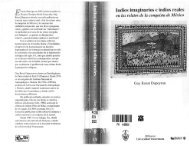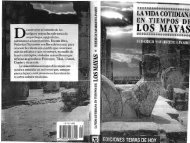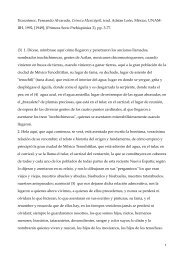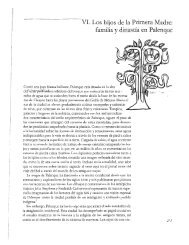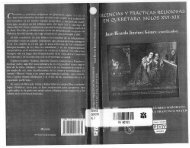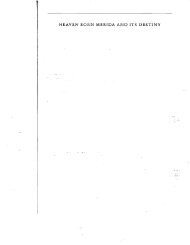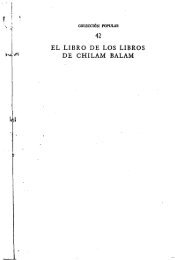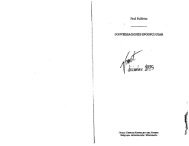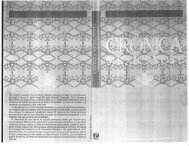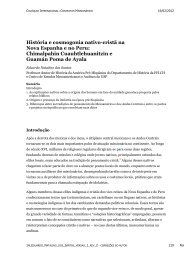1 - Histomesoamericana
1 - Histomesoamericana
1 - Histomesoamericana
You also want an ePaper? Increase the reach of your titles
YUMPU automatically turns print PDFs into web optimized ePapers that Google loves.
INTRODUCTION XV<br />
endogenous—view of the work. I believe I have done that. While my<br />
confidence has been shaken or my interpretation changed by some items<br />
of subsequent reading, others have encouraged me to stick to my guns.<br />
In learning Yucatecan Maya, I depended first on the production of a<br />
general dictionary incorporating all entries in Brasseur 1872, Pío Pérez<br />
1866-67, Swadesh, Alvarez, and Bastarrachea 1970, Blair and Vermont-<br />
Salas 1965, and Solís Alcalá 1949, plus additional vocabulary from Roys<br />
1931 and 1967, Redfield 1941, Tozzer 1941, and a substantial part of the<br />
Motul dictionary. I then prepared a root dictionary of my own (Edmonson<br />
n.d.b). I have also consulted Martínez Hernández 1929, Pacheco Cruz<br />
1969, and Pío Pérez 1898.1 lay no claim to speaking the language, but the<br />
language of the Tizimin is no longer spoken in any case.<br />
Besides the problems presented by the copyist's errors, the manuscript<br />
gives no reliable indication of vowel length and no real phrase or sentence<br />
punctuation or word division. Furthermore, the language is archaic. Even<br />
the latest passages are about 150 years old, and the earliest ones may go<br />
back 500 years or even more. In the First Chronicle, for example, we read:<br />
uac Ahau chuc cu lumil Chakan Putun (lines 49-52). If my translation is<br />
correct, this would be expressed in modern Maya something like: tz'oc u<br />
cubsic u lumil Chakan Putun e le uac Ahau i 'six Ahau finished the<br />
seating of the lands of Champoton'. The form le 'the', which is ubiquitous<br />
in modern Maya, does not occur at all in the Tizimin. The rare<br />
verb chuc strikes me as archaic in comparison with tz'oc 'finish'. Modern<br />
Maya would almost certainly use some form of cub, cul, or cut for 'sit,<br />
seat' rather than cu, which is also an archaism, and it would make freer<br />
use of pronouns [v) and demonstratives [e, i). While the verb-objectsubject<br />
ordering of noun phrases is not compulsory in modern Maya, it is<br />
much the commonest.<br />
Verbs with aspect markers [c, h, t), which I believe to be the only true<br />
verbs in Maya, together with fully expressed pronominal subjects and<br />
objects, are the exception rather than the rule in the Tizimin. There is<br />
instead a marked addiction to participial and substantival constructions<br />
depending for their verbal force upon the Mayan lack of the verb 'to be'.<br />
Thus (lines 170-175): ox lahun tun man i tz'ulob u yax ilc ob u lumil<br />
Yucatan 'thirteen (Ahau) then (was) the passing (of) the foreigners; (it was)<br />
their first sighting of the lands of Yucatan'.<br />
The style of the older texts particularly is terse but elegant. They are<br />
meant to be read and pondered rather than skimmed over or recited. I<br />
have tried to translate as literally as possible, representing every linguistic<br />
element of the Mayan text in English to the degree I could. Although<br />
indications of subject and object are often delayed for several phrases or<br />
clauses, leaving a literal translation quite stilted in English, I have nonetheless<br />
followed the Mayan order of things in order to preserve the couplet<br />
structure of the original. Every couplet in turn is represented in my<br />
interpretative translation, also in order, although I have felt free to alter<br />
the syntax to render more clearly what I think the text means. I have not<br />
changed the order of the ideas, but I have changed passive and participial<br />
to active constructions, broken the sentences at different points, and introduced<br />
my own paragraphing. Not all details are preserved in the interpretation,<br />
but they will be found in the literal translation, the Mayan text,<br />
and the index.



